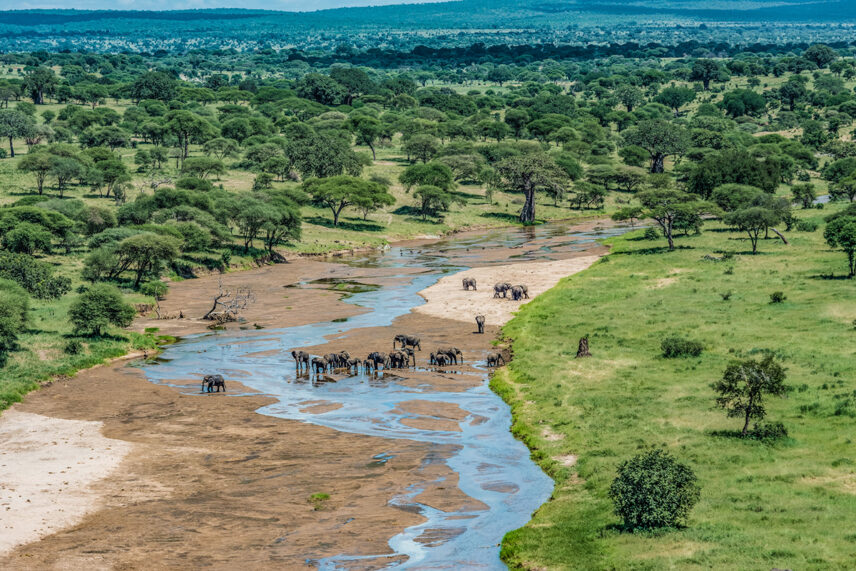The sun hangs low in the sky, and everything feels like it’s starting to slow down in the Serengeti when you notice that the Land Rover is stopping near a section of forest. You scan the horizon, looking for why you’ve paused. You look at your guide, Ojukwu. He’s not staring blankly into the distance with the rest of your group – he’s concentrating. Listening. It’s then that you start to feel it. A buzz. No, a hum. He catches your glance and mouths a single word: “Elephant.”

And that’s when the hum grows into a genuine sound – the groans, once infrasonic, become audible. Whatever it is, it’s in the trees, and coming closer. A trunk appears from the forest. Then another. And another. Soon, the herd reveals itself, a baritone choir towering over you.
Seeing elephants for the first time on safari is an exhilarating, soul-shaking experience — a highlight of any visit to Tanzania. Here are three of the best places for elephant sightings, each with unique qualities yet endowed with a similar magic.
The Serengeti

Along with lions, leopards, buffalos, and rhinos, elephants round out the wildlife of the Big 5 and make for the ideal Serengeti safari experience. Over 7,000 of these pachyderms preside over the park’s plains, grazing on shrubs and trees in the green season, and rely on grass in the drier months when water is in short supply. They put up with the influx of migrating wildebeest and others during the ungulates’ yearly march across the land, towering over them as they plod past on their way to their next destination. The elephants are often on the move, especially in the dry season as the water disappears.
Tarangire National Park

Nicknamed “the Little Serengeti,” this lush and beautiful national park has the world’s highest proportion – two to one – of elephants per square mile. An estimated 2,500 roam within Tarangire’s grounds, often traveling in herds of 300 as they cross the plains throughout the seasons. During the green season, they stand out even as swarms of other animals descend on the park for food, and fresh water, and the baobab trees, which are so large they often provide shade for the elephants themselves.

They can often be found near the Tarangire River and the Silale Swamp, enjoying the cool water. If you visit during the dry season, you may see an elephant digging up the dried riverbed for sponged-up water with their trunk. This benefits more than just the digger: once the elephant gets its fill, the watering hole remains for the other animals to enjoy.
Ngorongoro Crater

The land contained within the unbroken caldera of the Ngorongoro Crater is one of the Seven Wonders of the Natural World. Nurtured by long-settled volcanic ash, the flora on the crater’s floor attracts wildlife of all kinds. Chief among the many mammals you’ll see in the Ngorongoro Crater are elephants, which have a remarkable effect on the landscape. Their giant, heavy footsteps make natural footpaths used by much smaller animals.

Many of the elephants here are older, “retired” males with impressive tusks, perfect for pictures. But another fun fact about Ngorongoro’s elephants is that they dig caves in the caldera’s walls, and the areas near Gibb’s Farm. They dig into the cliffsides in search of salt and other dietary supplements, and the holes they leave behind are then turned into dens by other animals.
Each of these three places will provide you with astounding chances to see elephants, and on some of our safaris, you’ll get to visit all of them. With Thomson, you’ll do so comfortably, with knowledgeable guides who want to help you gain an even deeper appreciation for these fantastic animals.



